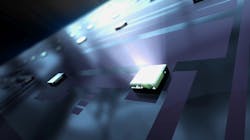Mini- and micro-LED technology is so temptingly on the horizon, appearing breathtakingly real like an oasis in the southwestern Nevada desert. But is it really here? Well, the initial applications for the technology are in TVs and displays, so we visited CES (formerly the Consumer Electronics Show) in Las Vegas just after New Year’s seeking insight. The demonstrations were spectacular and at least a few mini-LED products appear ready for market in 2020. The distance on the horizon to micro LED is less clear.
Mini- and micro-LED applications are poised to become a huge consumer of LED epitaxial real estate. The technologies are going to keep fabs busy. And we believe lessons learned in the initial TV and display applications will yield new uses not yet imagined in lighting, just as we have witnessed in general with solid-state lighting (SSL). That fact led us to the feature article we wrote on the topic late in 2019 that focused on large-scale direct-view or direct-emissive displays that use the smallest packaged LEDs while at the same time establishing a technology base for modular TV design, leading to use of the smaller LEDs in consumer products. Moreover, we plan to cover the mini/micro LED space more this year, digging into manufacturing techniques.
The definition of mini and micro LEDs is far from certain. We will use the term micro to describe LEDs that measure 100 μm per side or less and mini to describe LEDs that measure 100–300 μm per side. Without question, micro LEDs will require a new manufacturing process to transfer LED arrays to a substrate. Some mini-LED products will still be assembled using legacy pick-and-place technology, at least initially.
Residential TV walls
As has been the case for several years, micro-LED-based TVs that fill a home wall were featured products at CES. Stalwarts including Samsung and Sony continued their annual pizazz battle, and even upstarts from China such as TCL and Konka had similar demos. Samsung, for example, said “The Wall” modular TV will max out at 150-in.-horizontal sizes. The modular nature using building-block video panels means the company can offer many smaller sizes. The micro LEDs deliver screen brightness of 5000 nits, enabling use even in areas with significant ambient light as shown in Fig. 1.
Still, it’s not clear that any of these companies have sold these TVs into more than specialty applications with configurations approaching $1M (million). What we expected to see at CES was the start of mini-LED commercialization and the construction of a bridge to micro-LED technology. But understand: In displays, these LEDs aren’t used in the same way. Micro-LED TVs will be directly emissive like OLEDs. Mini LEDs will be used to backlight LCD screens. But the more granular arrays will deliver more granular dimming control and contrast ratios that match or exceed what OLEDs offer. And assuming the consumer electronics industry can master making mini-LED-based products, the TVs that use them will cost less and use less energy than OLEDs, while eliminating screen burn-in issues.
TCL Vidrian technology
It appears that Chinese manufacturer TCL will be the most aggressive mover into mini-LED TV technology. It’s strange to think about TCL as a company near the top of the TV market in terms of image quality. The company is about 40 years old but only became a serious player in TVs about five years ago. It quickly gained market share when it integrated the Roku streaming player in TVs and also sold them at value pricing. The company has zoomed to the third spot in terms of market share; it has asserted all along that its vertical integration strategy provides a significant cost-of-manufacturing advantage relative to competitors.
A few years back, the company made a significant image-quality move, offering quantum dot (QD) technology in what is now its 6 Series TVs (the TV portfolio includes 5, 6, and 8 Series with higher numbers having more features). The company even used the same QLED branding that Samsung uses and came close to matching the stalwart in quality. At CES this year, TCL said it would move the QLED technology down to the lowest-priced 5 Series products. And TCL said the mini-LED technology called Vidrian would come to market in 2020.
In fairness, TCL had shown mini-LED backlighting as part of the 8 Series line at CES last year. But that technology wasn’t widely commercialized in 2019. This year, the company said it will commercialize Vidrian technology in the 8 Series and even bring mini LEDs to mid-range 6 Series TVs later in the year.
Mini-LED benefits
We will be watching the market and offer an update when the mini-LED technology is broadly available. But let’s examine the technology in play. Since the advent of LED-backlit TVs and displays about a decade ago, a key advantage has been the ability to locally dim or brighten select areas of the screen. Control circuits could brighten areas of the screen where there was significant action occurring and even turn backlights off in dark areas, taking the screen to black. The technique greatly improved contrast ratios, and fluorescent backlights could not match the capability.
The first LED-backlit TVs had an array of packaged LEDs directly behind the screen in what was called a direct backlight, and such TVs remained relatively thick to provide room for the backlights given that the beam from each LED required some depth to spread and light its assigned screen area. Soon came edge-lit designs and much thinner TVs. But those products offered fewer backlight control zones for local dimming.
Mini LEDs will offer local dimming on steroids. Consider the TCL Vidrian products. The 75-in. model utilizes 25,000 mini LEDs in the backlight unit. Those LEDs are grouped into 1000 dimming control zones for what the company has called Quantum Contrast or Contrast Control Zones. Those mini LEDs work together with QLED technology to deliver bright saturated colors and completely black capabilities. You never know what to make of a tradeshow demo, but at CES TCL showed the Vidrian TV adjacent to an OLED model and displays of vivid red apples and strawberries were better on the mini-LED TV.
Cost and obstacles
The challenges of mini LED are obvious. You have to place 25,000 LEDs on some sort of backlight substrate in the manufacturing process, and you need to add a lot of driver circuits to control those LEDs — challenges that just escalate in the next evolution to micro LED. TCL will not say a lot about its implementation, but the company did provide images of the backlight layer shown in Fig. 2.
The LEDs are placed on a glass substrate along with the conductive traces to connect the LEDs in a matrix. That glass backlight unit becomes part of the layered sandwich that is the display panel. The LEDs in such a mini-LED backlight are very close to the LCD, providing better accuracy and uniformity, according to TCL. And the technology yields the thin profile of edge lighting with far better pictures.
TCL made one additional change in the Vidrian TV design relative to the first mini-LED TV shown a year ago. The backlight system on the first TV used a passive matrix design where only one side of the LED switched on and off. The Vidrian design uses an active matrix backlight where the connection to the anode and cathode of the LED is switched. The active matrix design can deliver faster response, less crosstalk, and fewer driver ICs — but at the cost of implementing transistors and capacitors on the backlight substrate. We will dig deeper in a future article.
Other mini-LED applications at CES
Mini-LED technology will be utilized in other types of displays. At CES, both Asus and Acer showed PC monitors in the 30-in. and larger range that use mini-LED backlighting. Primarily, these products are used by PC gaming enthusiasts, although prices for now will virtually limit applicability to the professional level. Acer’s 32-in. Predator X32 offers 3840×2160 resolution. The mini-LED backlight will deliver 1152 dimming zones — even more than the 75-in. TCL TV — and will sell for around $3600.
Asus, meanwhile, has some similar monitors but also a notebook PC called the ROG Zephyrus G14 that made unique use of what the company said were mini LEDs. The outer lid of the notebook has an array of 1000 LEDs that a user can customize with GIFs or scrolling text.






